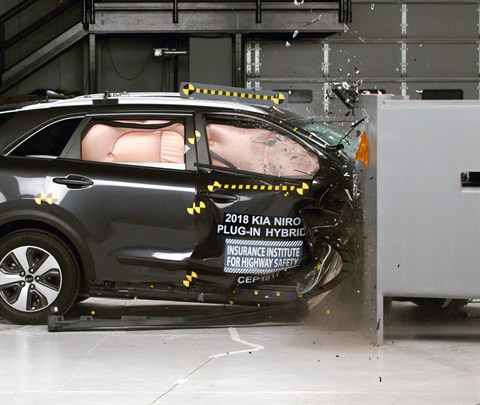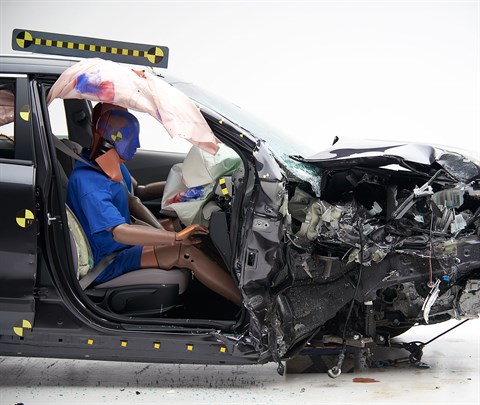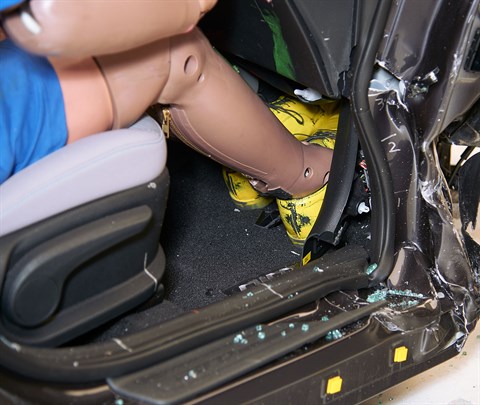Small overlap front: driver-side
Rating applies to 2018-22 models
Tested vehicle: 2018 Kia Niro Plug-In Hybrid LX wagon
The Kia Niro was introduced in the 2017 model year and is derived from the Hyundai Ioniq and Elantra. Like the Ioniq, the Niro is a hybrid with both a gasoline engine and electric motor. The Niro Plug-In Hybrid was introduced in the 2018 model year. This variant also uses a gasoline engine and electric motor, but the motor's lithium-ion battery can be charged by connecting it with an electrical cord to a standard household outlet.
Driver-side small overlap frontal ratings are assigned by the Institute based on a test of a Niro Plug-In Hybrid conducted by Hyundai/Kia. Ratings apply to both the Niro and Niro Plug-In Hybrid models.
| Evaluation criteria | Rating |
|---|---|
| Structure and safety cage | |
| Driver injury measures | |
| Head/neck | |
| Chest | |
| Hip/thigh | |
| Lower leg/foot | |
| Driver restraints and dummy kinematics | |
Small overlap front: passenger-side
Rating applies to 2018-22 models
Tested vehicle: 2018 Kia Niro Plug-In Hybrid LX wagon
The Kia Niro was introduced in the 2017 model year and is derived from the Hyundai Ioniq and Elantra. Like the Ioniq, the Niro is a hybrid with both a gasoline engine and electric motor. The Niro Plug-In Hybrid was introduced in the 2018 model year. This variant also uses a gasoline engine and electric motor, but the motor's lithium-ion battery can be charged by connecting it with an electrical cord to a standard household outlet.
Two passenger-side small overlap frontal tests of the Niro Plug-In Hybrid were conducted, one by the Institute and the other by Hyundai/Kia. Ratings are based on both tests and apply to both the Niro and Niro Plug-In Hybrid models.
| Evaluation criteria | Rating |
|---|---|
| Overall evaluation | |
| Structure and safety cage | |
| Passenger injury measures | |
| Head/neck | |
| Chest | |
| Hip/thigh | |
| Lower leg/foot | |
| Passenger restraints and dummy kinematics | |
| Driver injury measures | |
| Head/neck | |
| Chest | |
| Hip/thigh | |
| Lower leg/foot | |
| Driver restraints and dummy kinematics | |

Action shot taken during the Institute's passenger-side small overlap frontal crash test.

The dummy's position in relation to the door frame and dashboard after the crash test indicates that the passenger's survival space was maintained reasonably well (Institute test car shown).

The frontal and side curtain airbags worked well together to keep the head from coming close to any stiff structure or outside objects that could cause injury (Institute test shown).

The passenger's space was maintained reasonably well in both tests, but forces on the right lower leg were just high enough to indicate the possibility of injuries in the test conducted by the Institute (pictured). In the test conducted by Hyundai/Kia, injury risk to both legs and feet was low.
Moderate overlap front: original test
Rating applies to 2018-22 models
Tested vehicle: 2018 Kia Niro Plug-In Hybrid LX wagon
The Kia Niro was introduced in the 2017 model year and is derived from the Hyundai Ioniq and Elantra. Like the Ioniq, the Niro is a hybrid with both a gasoline engine and electric motor. The Niro Plug-In Hybrid was introduced in the 2018 model year. This variant also uses a gasoline engine and electric motor, but the motor's lithium-ion battery can be charged by connecting it with an electrical cord to a standard household outlet.
Moderate overlap frontal ratings are assigned by the Institute based on a test of a Niro Plug-In Hybrid conducted by Hyundai/Kia. Ratings apply to both the Niro and Niro Plug-In Hybrid models.
| Evaluation criteria | Rating |
|---|---|
| Overall evaluation | |
| Structure and safety cage | |
| Driver injury measures | |
| Head/neck | |
| Chest | |
| Leg/foot, left | |
| Leg/foot, right | |
| Driver restraints and dummy kinematics | |
Side: original test
Rating applies to 2018-22 models
Tested vehicle: 2018 Kia Niro Plug-In Hybrid LX wagon
The Kia Niro was introduced in the 2017 model year and is derived from the Hyundai Ioniq and Elantra. Like the Ioniq, the Niro is a hybrid with both a gasoline engine and electric motor. The Niro Plug-In Hybrid was introduced in the 2018 model year. This variant also uses a gasoline engine and electric motor, but the motor's lithium-ion battery can be charged by connecting it with an electrical cord to a standard household outlet.
Side ratings are assigned by the Institute based on a test of a Niro Plug-In Hybrid conducted by Hyundai/Kia. Ratings apply to both the Niro and Niro Plug-In Hybrid models.
| Evaluation criteria | Rating |
|---|---|
| Overall evaluation | |
| Structure and safety cage | |
| Driver injury measures | |
| Head/neck | |
| Torso | |
| Pelvis/leg | |
| Driver head protection | |
| Rear passenger injury measures | |
| Head/neck | |
| Torso | |
| Pelvis/leg | |
| Rear passenger head protection | |
Roof strength
Rating applies to 2018-22 models
Tested vehicle: 2018 Kia Niro hybrid LX wagon
Rating applies to both the Niro hybrid (tested) and Niro Plug-In Hybrid versions.
| Overall evaluation | |
|---|---|
| Curb weight | 3,138 lbs |
| Peak force | 19,696 lbs |
| Strength-to-weight ratio | 6.28 |
Head restraints & seats
Seat type: Manual cloth seat
| Overall evaluation | |
|---|---|
| Dynamic rating | |
| Seat/head restraint geometry |
About the head restraint & seat test
Currently, IIHS tests apply only to front seats.
Front crash prevention: vehicle-to-vehicle
Front crash prevention: pedestrian (day)
Child seat anchors
Rating applies to 2018-22 models
| Evaluation criteria | Rating |
|---|---|
| Overall evaluation | |
| Vehicle trim | LX |
| Seat type | cloth |
This vehicle has 2 rear seating positions with complete child seat attachment (LATCH) hardware.
It has 1 additional seating position with a tether anchor only.
| Evaluation criteria | Rating |
|---|---|
| Overall evaluation | |
| Vehicle trim | LX |
| Seat type | cloth |
| Rating icon | Rating |
|---|---|
| G | Good |
| A | Acceptable |
| M | Marginal |
| P | Poor |
| Seating positions that rely on borrowed lower anchors or have only a tether anchor available are not rated. | |
thether anchor symbol | Tether anchor |
lower anchor symbol | Lower anchors |
| Lower anchor(s) can be borrowed from adjacent positions(s) | |
| No hardware available |
Details by seating position
| Position | Rating |
|---|---|
| 1 | |
| Tether anchor | |
| easy-to-find location | |
| no other hardware could be confused for anchor | |
| Lower anchors | |
| too deep in seat | |
| not too much force needed to attach | |
| easy to maneuver around anchors | |
| 2 | |
| Tether anchor | |
| easy-to-find location | |
| no other hardware could be confused for anchor | |
| Lower anchors | |
| none available | |
| 3 | |
| Tether anchor | |
| easy-to-find location | |
| no other hardware could be confused for anchor | |
| Lower anchors | |
| too deep in seat | |
| not too much force needed to attach | |
| easy to maneuver around anchors |
